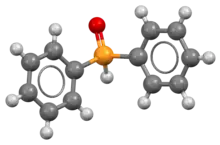Diphenylphosphine oxide
Diphenylphosphine oxide is an organophosphorus compound with the formula (C6H5)2P(O)H. It is a white solid that soluble in polar organic solvents.[1]
 | |
 | |
| Names | |
|---|---|
| Preferred IUPAC name
Diphenyl-λ5-phosphanone | |
| Identifiers | |
3D model (JSmol) |
|
| ChemSpider | |
PubChem CID |
|
| UNII | |
| |
| |
| Properties | |
| C12H11OP | |
| Molar mass | 202.19 |
| Appearance | white solid |
| Melting point | 56-57 °C |
Except where otherwise noted, data are given for materials in their standard state (at 25 °C [77 °F], 100 kPa).
Infobox references | |
Synthesis
Diphenylphosphine oxide can be prepared by the reaction of phosphonic esters, such as diethylphosphite, with Grignard reagents followed by acid workup:[2]
- (C2H5O)2P(O)H + 3 C6H5MgBr → (C6H5)2P(O)MgBr + C2H5OMgBr
- (C6H5)2P(O)MgBr + HCl → (C6H5)2P(O)H + MgBrCl
Alternatively, it may be prepared by the partial hydrolysis of chlorodiphenylphosphine[1] or diphenylphosphine.[3]
Reactions
Diphenylphosphine oxide exists in equilibrium with its minor tautomer diphenylphosphinous acid, ((C6H5)2POH:
- (C6H5)2P(O)H ⇌ (C6H5)2POH
Diphenylphosphine oxide is used in Buchwald-Hartwig coupling reactions to introduce diphenylphosphino substituents.[1]
Thionyl chloride converts diphenylphosphine oxide to chlorodiphenylphosphine.
Organophosphinous acids are deoxygenated with DIBAH. The resulting secondary phosphines are precursors to phosphine ligands.[4]
References
- Saunders, Jeffrey O.; Wang, Zheng; Ding, Kuiling (2007). "Diphenylphosphine Oxide". Encyclopedia of Reagents for Organic Synthesis. doi:10.1002/047084289X.rd428.pub2. ISBN 978-0-471-93623-7.
- Hunt, B. B.; Saunders, B. C. (1957). "Preparation and Reactions of Diphenylphosphine Oxide". J. Chem. Soc.: 2413–2414. doi:10.1039/JR9570002413.
- Rauhut, M. M.; Currier, Helen A. (November 1961). "Oxidation of Secondary Phosphines to Secondary Phosphine Oxides". The Journal of Organic Chemistry. 26 (11): 4626–4628. doi:10.1021/jo01069a102.
- Carl A. Busacca; Jon C. Lorenz; Paul Sabila; Nizar Haddad; Chris H. Senanyake (2007). "Synthesis Of Electron-Deficient Secondary Phosphine Oxides And Secondary Phosphines: Bis[3,5-bis(Trifluoromethyl)phenyl]phosphine Oxide And Bis[3,5-bis(Trifluoromethyl)phenyl]phosphine". Org. Synth. 84: 242. doi:10.15227/orgsyn.084.0242.